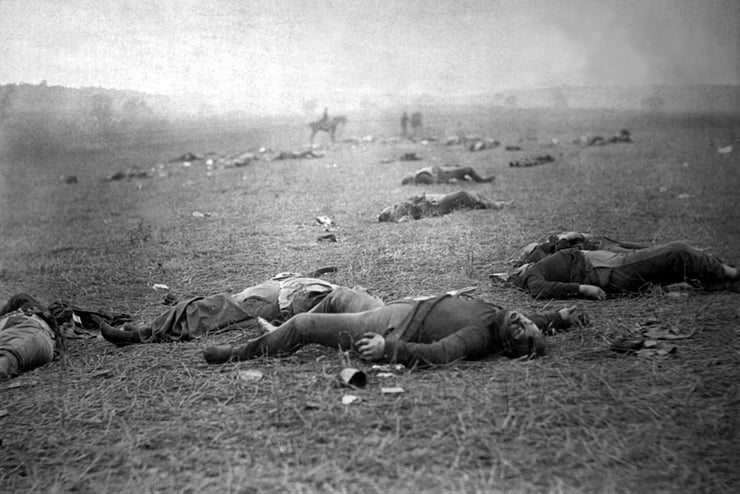Just two hours from where I sit writing this lies a battlefield where 50,000 American men and boys were wounded, killed, captured, or went missing over the course of three days roughly 160 years ago. Several months later, that field became a cemetery dedicated by President Abraham Lincoln in his famous Gettysburg Address, and a federally funded campaign to gather up the bodies of dead soldiers—not only at Gettysburg, but at other battles as well—was undertaken.
Yet the Union and Confederate soldiers who fell in the terrible business of trying to kill each other were treated differently in their deaths and burials. The South was outraged over this treatment while the North tried to justify their actions in terms of slavery and victory over the rebels.
But there are ways of making sense out of the massive wound of the Civil War that don’t simply reduce it to these elementary school terms. Simple narratives are attractive precisely because of their simplicity, but perhaps meaning-making of greater sophistication is more effective at renewing collective identity. Americans would benefit from learning this lesson in the way they approach the Civil War and its memorials even today.
The curiously selective burial treatment given to Civil War soldiers is a fact former Harvard president Drew Faust Gilpin described in her book, This Republic of Suffering:
Northern politicians made sense of this approach by doing what victors in war often do: blaming the losers for the entirety of the war’s destruction and thereby justifying this differential treatment, an approach with much historical precedence.
The outraged reaction of the South to the coarse treatment of their dead soldiers is routinely caricatured by members of today’s cultural elite. One National Review writer rejected such a reaction with the following insulting simplification: “As anyone with more than a sixth-grade education can tell you, one side made [its] stand on behalf of enslaving human beings.” This, in that pundit’s view, justifies the refusal to “compromise” in any substantive way on how to make sense of and commemorate the conflict and its casualties.
It is difficult to imagine how a divided country could conceivably have been patched up in the aftermath of a Civil War of such horrific destruction when the victors would not recognize the mutually sacred status of those fallen in combat on all sides. Yet much of America’s cultural memory operates according to a civil religion in which our history is placed within a broad framework of the elect status and spiritual struggles of the American people to remain in covenant with their God.
In this framework, the Civil War was the bloody, awful price that had to be paid for our chief moral failing—the institution of slavery—and the fallen, on both sides, are understood as martyred sacrifices for achieving our collective expiation. According to this mode of understanding, they had to die for the country to be reintegrated into the covenant. If we do not exalt them—all of them—in their sacrifice, we cannot ourselves have any hope of truly overcoming the moral stain that produced the necessity of their deaths.
Princeton’s Jim McPherson has documented the many factors compelling Civil War soldiers’ actions as detailed in their diaries and letters. Commitment to comrades in arms was an important force driving men on both sides. For Confederate soldiers, martial courage was an essential aspect of the Southern male identity. That Northern troops had entered the South to try to capture Richmond and end the war early supplied another reason for Southern soldiers to fight: a defense of their homeland against a perceived invasion. Will those who would like to class all who fought on the Southern side as monsters undeserving of consecrated burial and memory find a way to turn brotherly camaraderie, male bravery, and love of home into eternal evils as well?
To imagine every Northern soldier laying his life on the line solely due to his opposition to slavery, and every Southern combatant doing the same solely to defend it, denies the realities of how and why soldiers arrive at the ability to take the risks and perform the deeds they do.
One need not “compromise” on the moral status of slavery to recognize the sacred value of integrating all the Civil War dead into a consecrated community—physically and culturally—to a country desirous of unity. Efforts to attack monuments to the common soldier of the South—who did not determine his fight and who frequently fought largely or entirely for reasons distinct from the enslavement of blacks—with a crude, false moral superiority will only help exacerbate national divisions.
Walt Whitman, who nursed Union wounded, did not distinguish between the spiritual status of Northern and Southern dead in “Pensive on Her Dead Gazing.” He hears the Mother of All call to the Earth: “My dead absorb or South or North.” Or South or North. All are sacrosanct, he exhorts Nature to absorb and then exhale again in mystical material presence all the “torn bodies” in to the very air we breathe.
Correction: The original piece mistakenly referred to former Harvard President Drew Faust Gilpin as a male.
Image Credit:
Wikimedia Commons-Library of Congress, Timothy O’Sullivan

Leave a Reply